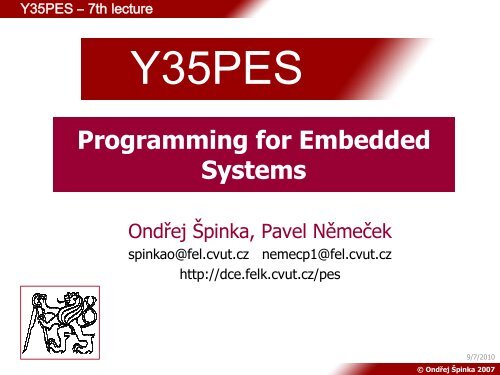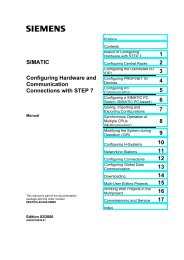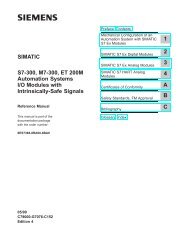Exceptions - DCE FEL ČVUT v Praze
Exceptions - DCE FEL ČVUT v Praze
Exceptions - DCE FEL ČVUT v Praze
You also want an ePaper? Increase the reach of your titles
YUMPU automatically turns print PDFs into web optimized ePapers that Google loves.
Y35PES – 7th lecture<br />
Y35PES<br />
`<br />
Programming for Embedded<br />
Systems<br />
Ondřej Špinka, Pavel Němeček<br />
spinkao@fel.cvut.cz nemecp1@fel.cvut.cz<br />
http://dce.felk.cvut.cz/pes<br />
9/7/2010<br />
© Ondřej Špinka 2007
Y35PES – 7th lecture<br />
<strong>Exceptions</strong> Handling (1)<br />
<strong>Exceptions</strong> are triggered by internal and external sources to cause the<br />
processor to handle an event. When a exception occurs, the execution is forced<br />
to go on from a fixed memory address, corresponding to the exception type.<br />
These addresses are called exception vectors, stored in so-called vector<br />
table. Seven types of exceptions exist in ARM (aligned in priority order):<br />
• Reset (supervisor mode)<br />
• Data memory access abort (abort mode)<br />
• FIQ (FIQ mode)<br />
• IRQ (IRQ mode)<br />
• Instruction prefetch abort (abort mode)<br />
• Undefined instruction (undefined mode)<br />
• Software interrupt (SWI) (supervisor mode)<br />
When an exception occurs, the LR (R14) and CPSR registers are automatically<br />
stored into the LR_ and SPSR_. LR is automatically<br />
decremented by 4 before being saved into LR_.<br />
9/7/2010<br />
© Ondřej Špinka 2007
Y35PES – 7th lecture<br />
<strong>Exceptions</strong> Handling (2)<br />
If multiple exceptions occur simultaneously, they are serviced in order of<br />
their priority. Exception handlers could be nested – should a higher<br />
priority exception occur when a lower priority exception is being serviced,<br />
it would interrupt the lower priority service routine.<br />
When executing user program, the processor runs in the user mode.<br />
When a exception occur, the mode is changed automatically into some<br />
kind of privileged mode. This also gives access into a dedicated set of<br />
banked registers:<br />
• R13 (Stack Pointer) – SP_<br />
• R14 (Link Register) – LR_<br />
• SPSR (Saved Program Status Register) – SPSR_<br />
• In case of FIQ also dedicated set of R8-R12 (R8_FIQ - R12_FIQ)<br />
Each exception handler must ensure that other registers are restored to<br />
their original state upon exit. This can be done by storing the contents of<br />
any registers the handler needs to use onto its stack and restoring them<br />
before returning.<br />
9/7/2010<br />
© Ondřej Špinka 2007
Y35PES – 7th lecture<br />
<strong>Exceptions</strong> Handling (3)<br />
The processor’s response to an exception:<br />
When a exception occurs, the processor does following:<br />
• Copies CPSR into SPSR_<br />
• Sets appropriate CPSR bits<br />
– To change the processor mode<br />
– To disable interrupts<br />
• Stores the return address (PC - 4) into LR_<br />
• Sets the PC to the appropriate vector address<br />
All actions noted above are performed automatically by the<br />
processor hardware.<br />
9/7/2010<br />
© Ondřej Špinka 2007
Y35PES – 7th lecture<br />
<strong>Exceptions</strong> Handling (4)<br />
Returning from the exception handler:<br />
The exception handler must perform following two actions<br />
prior to returning:<br />
• Restore CPSR from the SPSR_<br />
• Restore PC using the return address from LR_<br />
These can be achieved within a single instruction, because<br />
adding the S flag (update condition codes) to a data -<br />
processing instruction when in a privileged mode with the PC<br />
as the destination register also transfers the SPSR to CPSR<br />
as required.<br />
9/7/2010<br />
© Ondřej Špinka 2007
Y35PES – 7th lecture<br />
<strong>Exceptions</strong> Handling (5)<br />
The return address and return instruction:<br />
The actual value in the PC which causes a return from a<br />
handler varies with the exception type. When an exception is<br />
taken, the PC may or may not have been updated<br />
(depending on the exception type), and the return address<br />
may not necessarily be the next instruction pointed to by the<br />
PC, because of the way the ARM loads its instructions. When<br />
loading the instructions, the ARM uses a pipeline with a<br />
fetch, decode and execute stage. At any time, there will be<br />
one instruction in each stage of the pipeline. The PC actually<br />
points to the instruction being fetched. Since each instruction<br />
is a word long, the instruction being decoded is at address<br />
PC – 4 and the instruction being executed is at PC – 8.<br />
9/7/2010<br />
© Ondřej Špinka 2007
Y35PES – 7th lecture<br />
Interrupts Handling (1)<br />
Interrupts form a special subset of exceptions. There are<br />
two types of interrupts:<br />
• FIQ –Fast interrupt service. The processor is set to the<br />
FIQ mode. Exception vector is 0x0000001C.<br />
• IRQ –Normal interrupt service. The processor is set to the<br />
IRQ mode. Exception vector is 0x00000018.<br />
FIQs have higher priority then IRQs. If they occur<br />
simultaneously, the FIQ is serviced first. If a FIQ occurs<br />
during the IRQ servicing, it interrupts the IRQ service<br />
routine.<br />
9/7/2010<br />
© Ondřej Špinka 2007
Y35PES – 7th lecture<br />
Interrupts Handling (2)<br />
Returning from an interrupt handler:<br />
The IRQs or FIQs occurrence is checked after execution of<br />
each instruction. This means that a FIQ or IRQ is generated<br />
always after the PC had been updated, meaning that the<br />
next instruction is located at the address PC – 8. Because the<br />
PC is automatically decremented by 4 prior storing into the<br />
LR_, it must be decremented again by 4 prior to FIQ<br />
or IRQ handler return. Therefore, the return instruction from<br />
a FIQ or IRQ handler would be<br />
subs pc, lr, #4<br />
9/7/2010<br />
© Ondřej Špinka 2007
Y35PES – 7th lecture<br />
IRQ handling sequence:<br />
Assume that an IRQ occurred when<br />
executing instruction at address<br />
0x00001004.<br />
0x00000018<br />
0x00000D00<br />
0x00000F00<br />
0x00001000<br />
0x00001004<br />
0x00001008<br />
Interrupts Handling (3)<br />
Code<br />
mov pc, #0x00000D00<br />
…<br />
mov r4, r1<br />
…<br />
subs pc, lr, #4<br />
…<br />
ldr r10, [r0]<br />
mov r8, r10 IRQ event<br />
add r5, r5, r8<br />
0x00000000<br />
0x00000004<br />
0x00000008<br />
0x0000000C<br />
0x00000010<br />
0x00000018<br />
0x0000001C<br />
Vector Table<br />
Reset_handler<br />
Undef_handler<br />
SWI_handler<br />
Pabort_handler<br />
Dabort_handler<br />
IRQ_handler<br />
FIQ_handler<br />
PC (after execution)<br />
0x0000100C<br />
0x00001010<br />
0x00000018<br />
…<br />
0x00000D00<br />
…<br />
0x00000F0C<br />
0x00001008<br />
9/7/2010<br />
© Ondřej Špinka 2007
Y35PES – 7th lecture<br />
Writing an Interrupt Handler (1)<br />
There is a special keyword in the C language __irq,<br />
specifying that the following function is an interrupt handler<br />
(IRQ or FIQ).<br />
The __irq prefix means that all registers would be<br />
automatically stored/restored on the stack, CPSR would be<br />
restored from SPSR_ at the end of the function and<br />
that the return address to be used is LR_ - 4.<br />
void __irq irq_handler ( ) {<br />
}<br />
...<br />
9/7/2010<br />
© Ondřej Špinka 2007
Y35PES – 7th lecture<br />
Writing an Interrupt Handler (2)<br />
Alternatively, the IRQ (FIQ) handling function might be<br />
declared as:<br />
void irq_handler ( ) __attribute__ ( ( interrupt ) );<br />
void irq_handler ( ) {<br />
}<br />
...<br />
9/7/2010<br />
© Ondřej Špinka 2007
Y35PES – 7th lecture<br />
Writing an Interrupt Handler (3)<br />
Now the IRQ handler must be registered in the vector table, in order to<br />
be called when respective exception occurs. The simplest way to do that<br />
is to place a branch instruction to the handler into the address of the<br />
exception vector in the vector table. This only allows for branching within<br />
32MB memory space, however, this is sufficient in most cases. The<br />
required instruction can be constructed as follows:<br />
• Take the address of the exception handler<br />
• Subtract the address of the corresponding exception vector<br />
• Subtract 0x08 to allow for the pipeline<br />
• Shift the result two bits right to produce correct word-aligned offset<br />
• Check the top 8 bits to be clear, to allow for the instruction opcode<br />
• Logically or this with 0xEA000000 (BL instruction opcode)<br />
Now the resulting value can be placed to the vector address.<br />
9/7/2010<br />
© Ondřej Špinka 2007
Y35PES – 7th lecture<br />
Writing an Interrupt Handler (4)<br />
unsigned install_handler ( unsigned routine, unsigned *vector ) {<br />
}<br />
unsigned vec, oldvec;<br />
vec = (( routine – (unsigned) vector – 0x08 ) >> 2 );<br />
if ( vec & 0xFF000000 ) {<br />
}<br />
printf ( “installation of the handler failed!\n” );<br />
exit ( 1 );<br />
vec |= 0xEA000000;<br />
oldvec = *vector;<br />
*vector = vec;<br />
return oldvec;<br />
9/7/2010<br />
© Ondřej Špinka 2007
Y35PES – 7th lecture<br />
Writing an Interrupt Handler (5)<br />
void __irq irq_handler ( ) {<br />
}<br />
...<br />
void main ( ) {<br />
}<br />
unsigned old_vec;<br />
unsigned *irq_vec = (unsigned *) 0x18;<br />
old_vec = install_handler ( (unsigned) irq_handler,<br />
(unsigned) irq_vec );<br />
…<br />
9/7/2010<br />
© Ondřej Špinka 2007
Y35PES – 7th lecture<br />
Writing an Interrupt Handler (6)<br />
Registering a FIQ handler:<br />
To allow fastest possible FIQ reception and servicing, the<br />
FIQ vector is located at the very end of the vector table.<br />
Hence there is no need to perform any branch to the<br />
handler, instead the FIQ handler can (and should) begin<br />
directly at the FIQ vector address. This is achieved by<br />
copying the handler code directly to the address 0x1C. The<br />
ARM code is inherently relocatable, however, it must use PC<br />
relative addressing only (and therefore the data it uses must<br />
be relocated too).<br />
9/7/2010<br />
© Ondřej Špinka 2007
Y35PES – 7th lecture<br />
Writing an Interrupt Handler (7)<br />
Registering a FIQ handler in C:<br />
void __irq fiq_handler ( ) {<br />
}<br />
...<br />
void main ( ) {<br />
}<br />
memcpy ( 0x1C, fiq_handler, ? length_of_handler? );<br />
9/7/2010<br />
© Ondřej Špinka 2007
Y35PES – 7th lecture<br />
Writing an Interrupt Handler (8)<br />
What should an IRQ/FIQ handler do:<br />
• Determine what caused the interrupt<br />
• Branch to respective event handler (optional)<br />
• Handle the event<br />
• Return to normal program flow<br />
Interrupt handler time considerations:<br />
An interrupt handler should be kept as short and simple as<br />
possible, to prevent excessive latencies. Note that an<br />
interrupt in processing blocks any lesser and equal priority<br />
pending interrupts, therefore delaying their processing and<br />
introducing latency into the event handling.<br />
9/7/2010<br />
© Ondřej Špinka 2007
Y35PES – 7th lecture<br />
Lecture Summary – Essential Things to<br />
Remember<br />
• <strong>Exceptions</strong> provide a way to handle events, either<br />
internal or external.<br />
• When an exception occurs, the execution is forced to go on<br />
from a fixed memory address, corresponding to the<br />
exception type. These addresses are called exception<br />
vectors, stored in so-called vector table.<br />
• Interrupts form a special subset of exceptions. There are<br />
two types of interrupts: normal (IRQ) and fast (FIQ).<br />
• FIQs have higher priority then IRQs. If they occur<br />
simultaneously, the FIQ is serviced first. If a FIQ occurs<br />
during the IRQ servicing, it interrupts the IRQ service<br />
routine.<br />
9/7/2010<br />
© Ondřej Špinka 2007

















